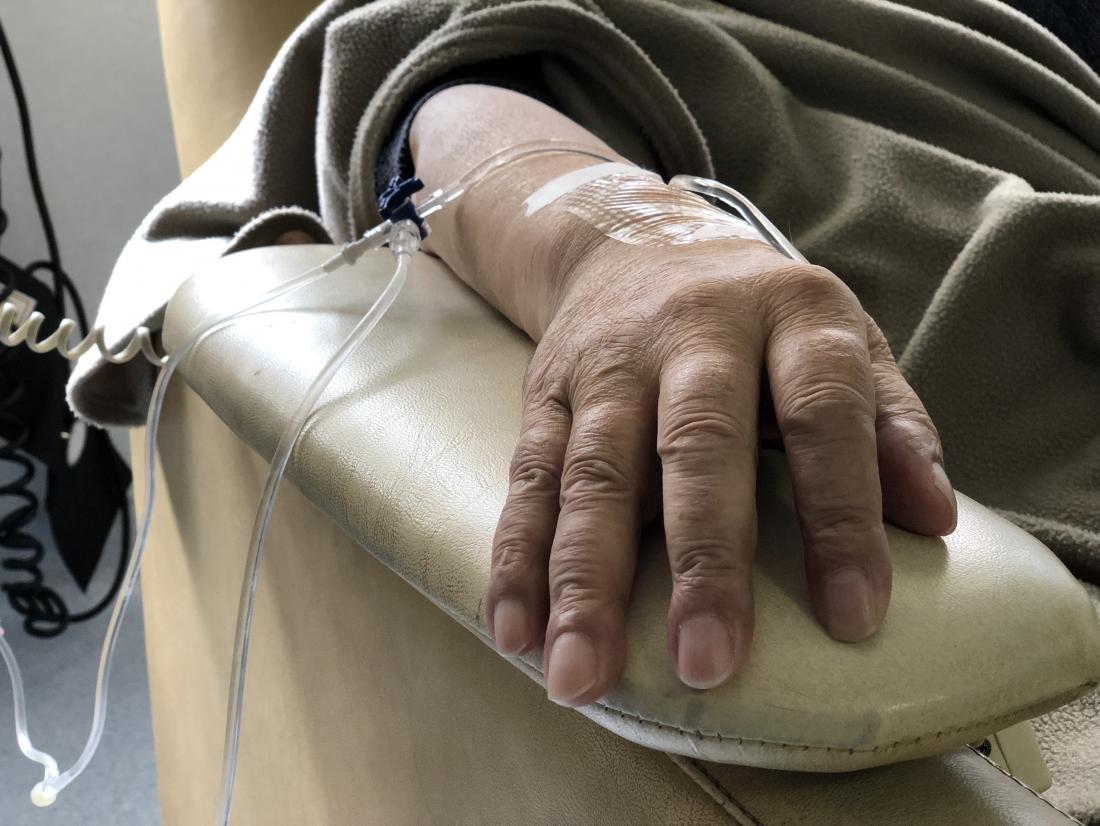This article outlines the use of chemotherapy drugs in the treatment of different cancers. We describe how many people with different types of cancer undergo chemotherapy as part of their treatment.
We also give information about survival rates for people with these types of cancer, according to the stage of cancer when a person received the diagnosis.
Factors affecting success and survival rates
There are a variety of factors that may affect how successful chemotherapy is and a person’s survival rate. These factors include:
Cancer survival rates

The factors affecting chemotherapy success rates can vary from person to person.
Cancer survival rates are one way to show how effective various treatments, including chemotherapy, can be.
A survival rate refers to the percentage of people who live for a certain amount of time after a cancer diagnosis.
Survival rates can also help people gain an understanding of their outlook because they provide information about the likely outcomes of people with similar cancers.
However, it is essential to remember that a range of factors influences survival rates and chemotherapy success rates. Many of these factors vary from person to person.
Cancer grade
Cancer grade is a measure of how abnormal the cancer cells appear under a microscope. More abnormal cells tend to grow and spread at a faster rate.
Cancer stage
Cancer stage indicates how large a tumor is and how far its cells have spread. A doctor can use various systems to determine what stage a cancer has reached.
They may use the following 0–5 scaling system:
- Stage 0: Abnormal cells are present but have not spread to nearby cells.
- Stages 1, 2, and 3: Cancer is present. Higher stages indicate larger tumors and a more extensive spread into nearby tissues.
- Stage 4: The cancer has spread to other areas of the body.
Researchers who collect data to determine cancer statistics may use the following terms to describe the cancer stage:
- In situ: Abnormal cells are present but have not spread to nearby tissues.
- Localized: Cancer has not spread beyond the place where it first developed.
- Regional: Cancer has spread to nearby lymph nodes, tissues, or organs.
- Distant: Cancer has spread to distant parts of the body.
Other factors
Other factors that can affect the success of chemotherapy include:
- age
- overall health
- any other medical conditions
In this article, we describe the next steps when chemotherapy is not effective.
Calculating chemo success rates for different cancers

Age and overall health may influence the success of chemotherapy.
People usually receive chemotherapy, or chemo, alongside other treatments, such as surgery and radiotherapy. This can make it difficult for researchers to determine which therapy has what effect.
As such, it is not possible to provide success rates for chemotherapy alone. The following examples show overall survival rates for people with different types of cancer, along with the percentage of those receiving chemotherapy as part of their treatment.
The statistics below are from the American Cancer Society’s 2016–2017 report on cancer treatment and survivorship. The figures all refer to people in the United States.
This report uses 5-year relative survival rates, which describe the percentage of people who live for at least 5 years after their cancer diagnosis.
Breast cancer
Most people with stage 1, 2, or 3 breast cancer undergo surgery as part of their treatment.
Some people may have a mastectomy, in which a surgeon removes the breast. Others may have breast conserving surgery (BCS), which involves removing the tumor and some of the surrounding healthy tissue.
Some people receive chemo with or instead of surgery.
The table below shows the percentages of females with breast cancer who undergo treatment involving chemotherapy, according to recent estimates.
| Breast cancer stage | |||
| Treatment choice | Stage 1 and 2 | Stage 3 | Stage 4 |
| BCS plus chemo | 2% | 2% | 2% |
| BCS plus radiotherapy and chemo | 17% | 15% | 2% |
| Mastectomy plus chemo | 12% | 13% | 7% |
| Mastectomy plus radiotherapy and chemo | 6% | 48% | 7% |
| Radiotherapy and/or chemo without surgery | 1% | 4% | 48% |
| Total | 38% | 82% | 66% |
Learn more about the stages of breast cancer here.
Breast cancer survival
The following table shows survival rates among females with breast cancer, depending on the stage at diagnosis.
| Breast cancer stage | |||
| Localized | Regional | Distant | |
| % of people with this stage of cancer at diagnosis | 61% | 32% | 6% |
| 5-year relative survival rate | 99% | 85% | 26% |
Colorectal cancer
This refers to cancer of the colon or rectum.
Surgical options for colorectal cancer include:
- Colectomy: removal of part or all of the colon.
- Proctectomy: removal of part or all of the rectum.
- Proctocolectomy: removal of the rectum and part or all of the colon.
Colon cancer
The table below shows the percentages of people with colon cancer who undergo treatment involving chemotherapy.
| Colon cancer stage | |||
| Treatment choice | Stage 1 & 2 | Stage 3 | Stage 4 |
| Colectomy and chemo | 10% | 67% | 40% |
| Chemo alone | less than 1% | less than 1% | 26% |
| Total | approx 11% | approx 68% | 66% |
Rectal cancer
The table below shows the percentages of people with rectal cancer who undergo treatment involving chemotherapy.
| Rectal cancer stage | |||
| Treatment choice | Stage 1 | Stage 2 & 3 | Stage 4 |
| Tumor removal/destruction plus chemo and/or radiotherapy | 4% | 2% | 1% |
| Proctectomy/proctocolectomy plus chemo and/or radiotherapy | 28% | 67% | 31% |
| Chemo and/or radiotherapy without surgery | 4% | 13% | 49% |
| Total | 46% | 82% | 80% |
Colorectal cancer survival
The following table gives information about survival rates for people with colorectal cancer, according to its stage at diagnosis.
| Colorectal cancer stage | |||
| Localized | Regional | Distant | |
| % of people with this stage of cancer at diagnosis | 39% | 36% | 20% |
| 5-year relative survival rate | 90% | 71% | 13% |
Find out more about colorectal cancer here.
Non-Hodgkin lymphoma
Non-Hodgkin lymphoma is a type of cancer that begins in cells called lymphocytes. These are immune system cells that help the body fight infection.
Around 69% of people with non-Hodgkin lymphoma receive chemo. Among them, 58% receive chemo alone, while 11% receive a combination of chemo and radiotherapy.
Non-Hodgkin lymphoma survival
The following table gives information about survival rates for people with non-Hodgkin lymphoma, according to its stage at diagnosis.
| Non-Hodgkin lymphoma stage | |||
| Localized | Regional | Distant | |
| % of people with this stage of cancer at diagnosis | 28% | 15% | 50% |
| 5-year relative survival rate | 82% | 74% | 62% |
Learn more about lymphoma here.
Lung cancer
There are two types of lung cancer: small-cell and non-small cell (N-SC).
Around 13% of lung cancers are small-cell. Most people with this type receive chemotherapy.
Approximately 83% of lung cancers are N-SC. The remaining 3% are undefined.
The table below gives information about the types of treatment that people with N-SC lung cancer receive.
| N-SC lung cancer stage | ||
| Treatment choice | Early stage (1 & 2) | Late stage (3 & 4) |
| Surgery plus chemo and/or radiotherapy | 16% | 7% |
| Chemo alone | 1% | 18% |
| Chemo plus radiotherapy without surgery | 6% | 35% |
| Total | 24% | 60% |
Lung cancer survival
The following table shows survival rates for people with N-SC lung cancer, according to the stage at diagnosis.
| N-SC lung cancer stage | |||
| Localized | Regional | Distant | |
| % of people with this stage of cancer at diagnosis | 16% | 22% | 57% |
| 5-year relative survival rate | 55% | 27% | 4% |
Find out more about lung cancer here.
Testicular cancer
Testicular cancer is cancer in one or both testicles. Around 97% of testicular cancers begin in the germ cells. These are cells that develop into sperm.
Tumors that develop from germ cells are called testicular germ cell tumors. There are two types: seminomatous tumors, which tend to be slow-growing, and non-seminomatous tumors, which usually grow more rapidly.
Seminomatous tumors
The table below shows the percentages of males who undergo treatment involving chemotherapy for early or late stage seminomatous testicular germ cell tumors.
| Seminomatous tumor stage | ||
| Treatment choice | Early stage (1 & 2) | Late stage (3 & 4) |
| Surgery plus chemo | 22% | 66% |
| Surgery plus chemo and radiotherapy | less than 1% | 4% |
| Chemo and/or radiotherapy without surgery | 1% | 21% |
| Total | approx. 24% | 91% |
Nonseminomatous tumors
The table below shows the percentages of males who undergo treatment involving chemotherapy for early or late stage nonseminomatous testicular germ cell tumors.
We also show the percentage of those who undergo a procedure called retroperitoneal lymph node dissection (RPLND).
| Nonseminomatous tumor stage | ||
| Treatment choice | Early stage (1 & 2) | Late stage (3 & 4) |
| Surgery and chemo | 35% | 67% |
| Surgery, chemo, and RPLND | 9% | 18% |
| Chemo and/or radiotherapy without surgery | less than 1% | 8% |
| Total | approx. 45% | 93% |
Testicular cancer survival
The following table shows information about survival rates for males with testicular cancer, according to its stage at diagnosis. These figures combine data from people with either type of tumor.
| Testicular cancer stage | |||
| Localized | Regional | Distant | |
| % of people with this stage of cancer at diagnosis | 68% | 18% | 12% |
| 5-year relative survival rate | 99% | 96% | 74% |
Learn more about testicular cancer here.
Bladder cancer

A doctor may suggest a cystectomy for a person with bladder cancer.
Most people with bladder cancer receive one of the following surgeries:
Transurethral resection of the bladder tumor, a minimally invasive procedure that involves removing the bladder tumor via the urethra.
Cystectomy, which involves removing part or all of the bladder, as well as the surrounding fatty tissue and lymph nodes.
About 52% of people with bladder cancer receive some form of chemotherapy treatment. Among them:
- 20% undergo cystectomy plus chemo, radiotherapy, or both
- 20% undergo transurethral resection plus chemo or radiotherapy
- 9% undergo transurethral resection plus chemo and radiotherapy
- 3% undergo chemo, radiotherapy, or both, but no surgery
Bladder cancer survival
The 5-year relative survival rate for localized bladder cancer varies by the type of cancer. Around 25% of bladder cancers invade the muscle wall of the bladder.
The 5-year relative survival rate is 47% for localized, muscle-invasive bladder cancer, and 81% for localized bladder cancer that is not muscle-invasive.
The following table shows more information about survival rates for people with bladder cancer, according to the stage at diagnosis. Figures for invasive and noninvasive cancers are combined.
| Bladder cancer stage | ||||
| In situ | Localized | Regional | Distant | |
| % of people with this stage of cancer at diagnosis | 51% | 35% | 7% | 4% |
| 5-year relative survival rate | 96% | 70% | 34% | 5% |
Find out more about bladder cancer here.
Uterine cancer
More than 90% of uterine cancers occur in the uterine corpus, the upper part of the uterus.
The table below shows the percentages of women who undergo treatment involving chemotherapy for uterine corpus cancer by stage.
| Uterine corpus cancer stage | ||
| Treatment choice | Early stage (1 & 2) | Late stage (3 & 4) |
| Surgery plus chemo | 5% | 33% |
| Surgery plus chemo and radiotherapy | 6% | 28% |
| Chemo and/or radiotherapy without surgery | 1% | 12% |
| Total | 12% | 73% |
Uterine corpus cancer survival
The following table shows information about survival rates among people with uterine corpus cancer, according to its stage at diagnosis.
| UCC stage | |||
| Localized | Regional | Distant | |
| % of people with this stage of cancer at diagnosis | 67% | 21% | 8% |
| 5-year relative survival rate | 95% | 68% | 17% |
Uterine cancer is also called endometrial cancer. Learn more here.
Outlook
Usually, people receive chemotherapy alongside other treatments. This makes it difficult to determine a person’s survival rate and success with chemotherapy alone.
Many other factors affect treatment success, including the type and stage of cancer, as well as personal characteristics, such as age and overall health.
Survival rates provide an estimate based on the outcomes of people with similar cancer diagnoses.
A doctor, especially an oncologist, can take all the relevant factors into account and give a better idea about a person’s outlook.
